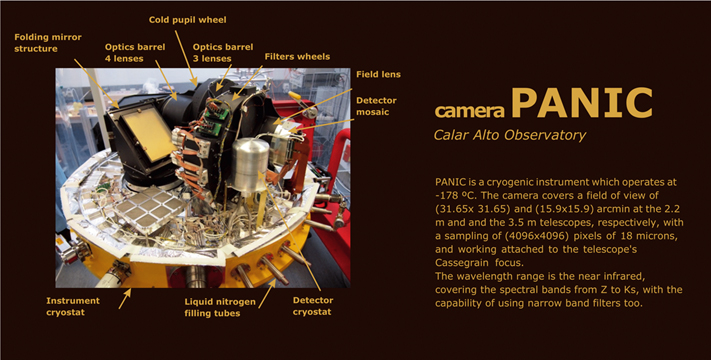A thesis developed at the IAA is awarded the 2020 MERAC 2020 in new technologies (Instrumental)
The optical engineer Concepción Cárdenas Vázquez has been awarded the MERAC Prize for the Best Doctoral Thesis in New Technologies (Instrumental) by the European Astronomical Society (EAS). The thesis encompasses the development of PANIC, an infrared, wide-field camera that operates on the Calar Alto Observatory
FONDATION MERAC (Mobilising European Research in Astrophysics and Cosmology) and the European Astronomical Society (EAS) awards biyearly the MERAC prize to the best thesis developed in Europe, an award that seeks to promote innovative research in astrophysics and cosmology and support young researchers. The prize, 25,000 euros, in the category of New Technologies, Instrumental, has been awarded in 2020 to the thesis of Concepción Cárdenas "PANIC, a large field infrared camera for Calar Alto", developed at the Institute of Astrophysics of Andalusia (IAA-CSIC).
“The thesis includes the complete development life of an astronomical instrument, from the conceptual design and the feasibility study to the final integration and verification, either in the laboratory as well as at the telescopes, following all the standard processes and exhaustive design revisions”, says Concepción Cárdenas, who is currently working at the Max-Plack Institut für Astronomie (MPIA), in Heidelberg (Germany), and who, on the occasion of the award, will present her thesis at one of the plenary sessions of the meeting of the European Astronomical Society that will take place in July this year.
CAMERA PANIC
PANIC belongs to the new generation of wide field infrared cameras for ground-based telescopes and it is the first of its kind in the northern hemisphere belonging to the Spanish astronomical community. It is a highly versatile instrument. Many science cases benefit from its wide field of view and from the filters, it includes, from extragalactic astronomy to the study of the Solar System, and it is an ideal instrument to perform large survey-type observations. PANIC can contribute as well to the study of star formation, gamma ray bursts or very distant quasars.

“The development of the camera included various important challenges – Concepción Cárdenas (MPIA) points out -, due to the large field of view required on the 2.2 m telescope and to the desired wavelength range that comprises the whole near-infrared). Firstly, we had to face the challenge of designing large size lenses, optimizing a system with severe off-axis aberrations (in particular, astigmatism and field curvature), as well as minimizing chromatic aberrations due to the wide spectral range. Secondly, PANIC operates attached to the Cassegrain focus of the telescope which imposes the challenge of folding the optical path and fitting the instrument into a quite limited envelope.”
Its special features make PANIC unique among the few instruments of this kind existing at present. The camera operates in the near infrared, a wavelength range that requires vacuum conditions and cryogenic systems to cool the instrument down to -178° C. Its large field of view covers the full Moon on the 2.2 m telescope, and on the 3.5 m telescope, Jupiter and its main moons (or Galilean satellites). The instrument performance, like the plate scale, the field of view, the image quality, and the distortion across the full field, as measured at both telescopes, confirms that PANIC fulfills all of the requirements. Observations with PANIC allow the astronomical community to tackle innovative and original science projects.

CONCEPCIÓN CÁRDENAS

From 1999 to 2016, Concepción Cárdenas worked at the Institute of Astrophysics of Andalusia (IAA-CSIC) as an optical engineer responsible, among other duties, for the optical package of PANIC and the spectrograph CARMENES (Calar Alto high-Resolution search for M dwarfs with Exoearths with Near-infrared and optical Echelle Spectrographs) NIR channel, as well as the Optics Laboratory and its optical team, and providing optical support to the Sierra Nevada Observatory (OSN).
In parallel, she developed her doctoral thesis, advised by Julio F. Rodríguez (IAA-CSIC) and defended in December 2018.
Since 2016, Concepción Cárdenas is a staff member at MPIA (Heidelberg). Her work here focuses on the instrumentation for the ELT (European Extremely Large Telescope).
In June 2019 she was also awarded for this thesis the prize for the best Spanish PhD in Instrumentation, Computing and Technological Development in Astronomy and Astrophysics, 2017-2018, from the Spanish Astronomical Society (SEA).
Press Release of MERAC Prizes: : https://eas.unige.ch/merac_prizes.jsp
Thesis full text from Concepción Cárdenas Vázquez available at: http://digibug.ugr.es/handle/10481/54456
Instituto de Astrofísica de Andalucía (IAA-CSIC)
Unidad de Divulgación y Comunicación
Silbia López de Lacalle - sll[arroba]iaa.es - 958230676
https://www.iaa.csic.es
https://divulgacion.iaa.csic.es

